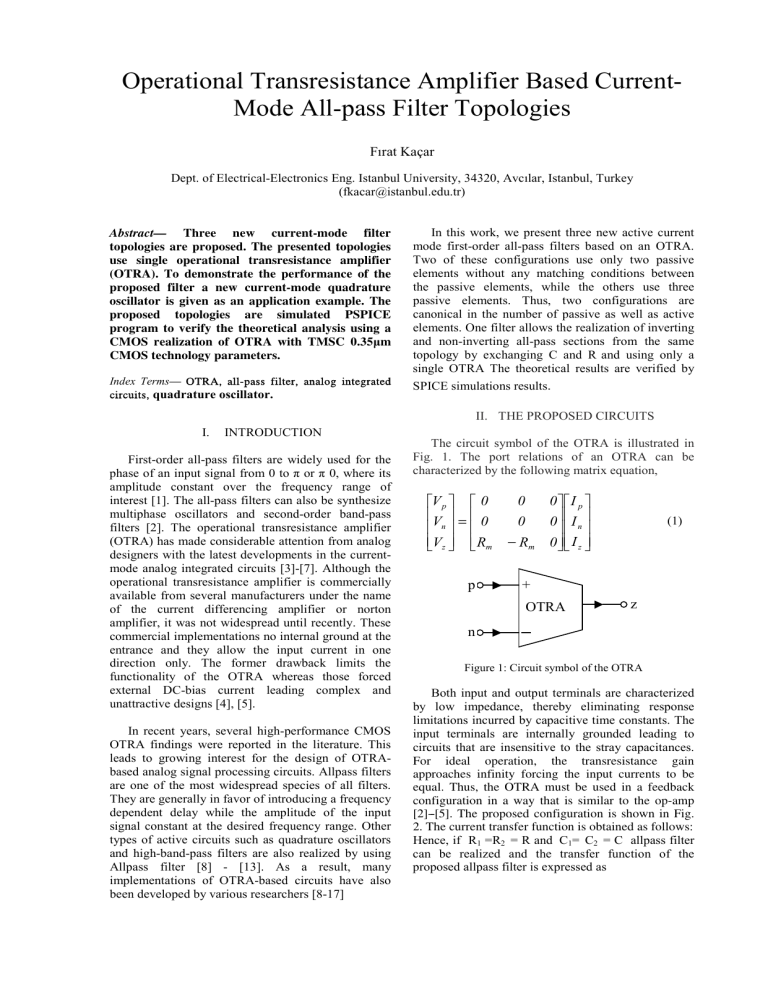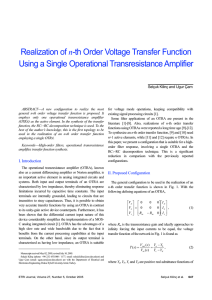Operational Transresistance Amplifier Based Current

Operational Transresistance Amplifier Based Current-
Mode All-pass Filter Topologies
F
ı
rat Kaçar
Dept. of Electrical-Electronics Eng. Istanbul University, 34320, Avc ı lar, Istanbul, Turkey
(fkacar@istanbul.edu.tr)
Abstract— Three new current-mode filter topologies are proposed. The presented topologies use single operational transresistance amplifier
(OTRA). To demonstrate the performance of the proposed filter a new current-mode quadrature oscillator is given as an application example. The proposed topologies are simulated PSPICE program to verify the theoretical analysis using a
CMOS realization of OTRA with TMSC 0.35
μ m
CMOS technology parameters.
Index Terms —
OTRA, all-pass filter, analog integrated circuits, quadrature oscillator.
I.
INTRODUCTION
First-order all-pass filters are widely used for the phase of an input signal from 0 to π or π 0, where its amplitude constant over the frequency range of interest [1]. The all-pass filters can also be synthesize multiphase oscillators and second-order band-pass filters [2]. The operational transresistance amplifier
(OTRA) has made considerable attention from analog designers with the latest developments in the currentmode analog integrated circuits [3]-[7]. Although the operational transresistance amplifier is commercially available from several manufacturers under the name of the current differencing amplifier or norton amplifier, it was not widespread until recently. These commercial implementations no internal ground at the entrance and they allow the input current in one direction only. The former drawback limits the functionality of the OTRA whereas those forced external DC-bias current leading complex and unattractive designs [4], [5].
In recent years, several high-performance CMOS
OTRA findings were reported in the literature. This leads to growing interest for the design of OTRAbased analog signal processing circuits. Allpass filters are one of the most widespread species of all filters.
They are generally in favor of introducing a frequency dependent delay while the amplitude of the input signal constant at the desired frequency range. Other types of active circuits such as quadrature oscillators and high-band-pass filters are also realized by using
Allpass filter [8] - [13]. As a result, many implementations of OTRA-based circuits have also been developed by various researchers [8-17]
In this work, we present three new active current mode first-order all-pass filters based on an OTRA.
Two of these configurations use only two passive elements without any matching conditions between the passive elements, while the others use three passive elements. Thus, two configurations are canonical in the number of passive as well as active elements. One filter allows the realization of inverting and non-inverting all-pass sections from the same topology by exchanging C and R and using only a single OTRA The theoretical results are verified by
SPICE simulations results .
II.
THE PROPOSED CIRCUITS
The circuit symbol of the OTRA is illustrated in
Fig. 1. The port relations of an OTRA can be characterized by the following matrix equation,
⎡
⎢
⎢
⎢
V
V
V p n z
⎤
⎥
⎥
⎦
=
⎢
⎣
⎡
⎢
0
0
R m
−
0
0
R m
0 ⎤
⎥
0
0
⎥
⎦
⎢
⎣
⎡
⎢
I
I
I n p z
⎥
⎦
⎤
⎥
(1) p n
+
OTRA z
Figure 1: Circuit symbol of the OTRA
Both input and output terminals are characterized by low impedance, thereby eliminating response limitations incurred by capacitive time constants. The input terminals are internally grounded leading to circuits that are insensitive to the stray capacitances.
For ideal operation, the transresistance gain approaches infinity forcing the input currents to be equal. Thus, the OTRA must be used in a feedback configuration in a way that is similar to the op-amp
[2]---[5]. The proposed configuration is shown in Fig.
2. The current transfer function is obtained as follows:
Hence, if R
1
=R
2
= R and C
1
= C
2
= C allpass filter can be realized and the transfer function of the proposed allpass filter is expressed as
I out
I in
=
1 −
1 +
sCR sCR (2)
This transfer function allows the designer both inverting and non-inverting types of first order current mode all-pass filters by exchanging C and R
ϕ π 2 arctan ω
RC (3) and using only a single OTRA for Figure 2.c. Phase angle of the filter is computed as p
OTRA z n
I out
I out
I in
=
⎛
⎝
⎞
⎠
R
1
= R
2
= R and C
1
= C
R
1
R
2 C
I in
(a)
C
I in p
OTRA z n
I out
I out
I in
=
⎛
⎝
⎞
⎠
R
(b)
I in
R p
OTRA z n
I out
I out
I in
=
⎛
⎝
⎞
⎠
C
(c)
Figure 2 : The proposed first order all-pass filter topologies
III.
SIMULATION RESULTS parameters were TMSC from the 0.35
μ m CMOS process. Supply voltages are 1.5 V and -1.5 V. In order to verify the theoretical results, the first all-pass
All-pass filters are one of the most important building blocks of many analog signal-processing applications and therefore have received much attention. They are filter was simulated using PSPICE program. The circuit of Figure 2.b. was for a 90 o phase-shift to 1.59
MHz. The values, like C = 10pF and R = 1k Ω . The results for the simulated response are given in Figure generally used for introducing a frequency dependent delay while keeping the amplitude of the input signal constant over the desired frequency range.
To demonstrate the applicability of the proposed allpass filter, SPICE circuit simulations have been associated with a CMOS realization of OTRA. Model
4.a. Also, a phase shifter, with the same topology through the exchange of C and R All-pass Figure 2.b.
90 o for a phase-shift to 1.59 MHz. The values of the components were as described above and the results for the frequency response are given in Figure 4.b.
The results for the frequency response of the proposed circuits are in agreement with the theory. Figure.5 shows the time-domain response of the filter. A sinusoidal input to the frequency from 1.59 MHz, was on the all-pass network with the above-mentioned passive element values.
V
DD
M
8
M
14
I
0
M
1
M
2
I
0
M
7
M
3
M
4 n
M
10
M
11
V g1
M
5 p
M
6
M
12
V g2
M
9
M
13
M
16
M
17
M
19
M
18
M
15
M
20
V w w
V
SS
Figure 3: A CMOS implementation of the OTRA [11]
Figure 4: Simulated gain and phase plots of inverting (a) and non-inverting (b) all-pass circuit of Fig. 2a at f o
=1.59 MHz
Figure 5: Simulated time-domain response of the proposed all-pass filter
IV.
QUADRATURE OSCILLATOR AS AN
ALL-PASS FILTER APPLICATION
To illustrate an application of the presented allpasss first-order filters, a quadrature oscillator is cascaded through a revolution and noninverting Allpass filter and close the loop, a loop gain of -1 at the pole frequency. The resulting circuit is shown in Figure. 6.
Frequency of vibration can be
ω
0
=
1
RC
(4)
By choosing R=lk Ω and C=10pF the calculated of the oscillation frequency is found as f o
=l.59MHz which is in close agreement with the simulated result. The simulated waveforms of the oscillator are shown in
Figure.7.
C R p p
OTRA z OTRA z n
I
1 n
I
2
R C
Figure 6: OTRA-based quadrature oscillator constructed by two allpass filters
Figure 7: Output waveforms of the allpass-based quadrature oscillator
V.
CONCLUSION
In this paper, three current-mode first-order all-pass filters are presented. All filters by a single OTRA.
Two of these filter configurations, including all the canonical-pass filter, the two passive elements, while the other three, the passive elements. The feasibility of the proposed first-order Allpass filter is applied to the design of a quadrature oscillator. The theoretical results were presented by SPICE simulations results.
It is expected that they provide further possibilities to the designer in the realization of analog integrated circuits.
VI.
REFERENCES
[1] Ponsonby JEB (1966) Active all-pass filter using a differential operational amplifier. Electron Lett 2:134–
135
[2] Comer DT, Comer DJ, Gonzalez JR (1997) A high frequency integrable band-pass filter configurations.
IEEE Trans Circuit Syst II 44:856–860
[3] C. Toumazou, F. J. Lidgey, and D. Haigh, Analog IC
Design: The Current-Mode Approach . Exeter, U.K.:
Peter Peregrinus, 1990.
[4] K. N. Salama and A. M. Soliman, ‘‘CMOS operational transresistance amplifier for analog signal processing applications,’’ Microelectron. J.
, vol. 30, pp. 235---245, 1999.
[5] , ‘‘Novel oscillators using operational transresistance amplifier,’’ Microelectron. J.
, vol. 31, pp. 39---47,
2000.
[6] J. Chen, H. Tsao, S. Liu, andW. Chui, ‘‘Parasitic capacitance insensitive current-mode filters using operational transresistance amplifier,’’ Proc.IEE
Circuit Devices Syst.
, vol. 142, no. 3, pp. 186---192,
1995.
[7] J. Chen, H. Tsao, and C. Chen, ‘‘Operational transresistance amplifier using CMOS technology,’’
Electron. Lett.
, vol. 28, no. 22, pp. 2087---2088, 1992.
[8] R. Schauman and M. E. Van Valkenburg, Design of
Analog Filters . New York: Oxford Univ. Press, 2001.
[9] D. T. Comer, D. J. Comer, and J. R. Gonzalez, ‘‘A high frequency integrable band-pass filter configuration,’’ IEEE Trans. Circuits Syst. II, Analog
Digit. Signal Process.
, vol. 44, no. 10, pp. 856---860,
Oct. 1997.
[10] O. Cicekoglu, H. Kuntman, and S. Berk, ‘‘Single
CCII+ based all-pass filters,’’ Int. J. Electron.
, vol. 86, no. 8, pp. 947---955, 1999.
[11] U. Çam, O. Cicekoglu, M. Gülsoy, and H. Kuntman,
‘‘New voltage and current mode first-order all-pass filters using single FTFN,” Freq.
, vol. 54, no. 7–8, pp.
177–179, 2000.
[12] M. Higashimura and Y. Fukui, “Realization of allpass and notch filters using a single current conveyor,” Int. J. Electron.
, vol. 65, pp. 823–828,
1988.
[13] A. Toker, S. Özoguz, O. Cicekoglu, and C. Acar,
“Current-mode allpass filters using current differencing buffered amplifier and new high-Q bandpass filter configuration,” IEEE Tran. Circuits
Syst. II, Analog Digit. Signal Process.
, vol. 47, no. 9, pp. 949–954, Sep. 2000.
[14] C. Cakir, U. Cam A., O. Cicekoglu, and C. Acar,
“Novel allpass filter configuration employing single
OTRA” IEEE Tran. Circuits Syst. II, vol. 52, no. 3, pp. 122–125, March 2005.
[15] U. Çam, F. Kaçar, O. Çiçeko ğ lu, H. Kuntman, and A.
Kuntman, “Novel Grounded Parallel Immitance
Simulator Topologies Employing Single OTRA.”
AEÜ – Int’l J. of Electronics and Communications , vol. 57, 4, 2003, pp 287-290.
[16] Y. S. Hwang, D.S. Wu, J. J. Chen , C. C. Shih and W.
S. Chou “Design of current-mode MOSFET-C filters using OTRAs” Int. J. Circ. Theor. Appl. (2008)
(Published Online).




